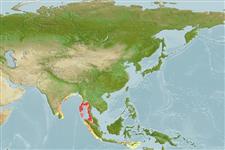>
Acanthuriformes (Surgeonfishes) >
Lobotidae (Tripletails)
Etymology: Hapalogenys: Greek, hapalos = soft * Greek, geny, -yos = face (Ref. 45335); merguiensis: Named for its type locality, Mergui Basin, southern Myanmar Sea..
Environment: milieu / climate zone / depth range / distribution range
Ecologia
marinhas; intervalo de profundidade 78 - 180 m (Ref. 36944). Tropical
Eastern Indian Ocean: known only from the Andaman Sea, off southern Myanmar, including Mergui Basin and Taninthayi Coast, and off Phuket, west coast of Thailand. Possibly occurring in the Andaman and Nicobar islands, Bay of Bengal and Straits of Malacca.
Tamanho / Peso / Idade
Maturity: Lm ? range ? - ? cm
Max length : 17.9 cm SL macho/indeterminado; (Ref. 36944); 24.2 cm SL (female)
Descrição suscinta
Chaves de identificação | Morfologia | Morfometria
Espinhos dorsais (total) : 6; Raios dorsais (total) : 14; Espinhos anais: 3; Raios anais : 9 - 10; Vértebras: 24. Head and body generally dark brownish when fresh. Two indistinct oblique dark bands on body, the first descending from the nape to behind the pectoral fin; the second from base of anterior 2nd or 3rd dorsal fin spines and soft dorsal fin base, curving backward thru the lateral line to soft anal fin and caudal peduncle. Maxillary scales absent. Eye diameter greater than one quarter of the head length. Ten pores on and behind the chin; often with slitlike pores posteriorly. Fleshy lower lip with a cluster of very short dense papillae. At the origin of the dorsal fin is a procumbent spinelike process (exposed tip of first pterygiophore) (Ref. 36944).
Occurs over rocky bottom.
Ciclo de vida ou comportamento de acasalamento
Maturities | Reprodução | Spawnings | Egg(s) | Fecundities | Larvas
Iwatsuki, Y., U. Satapoomin and K. Amaoka, 2000. New species: Hapalogenys merguiensis (Teleostei; Perciformes) from Andaman Sea. Copeia 2000(1):129-139. (Ref. 36944)
Status na Lista Vermelha da UICN (Ref. 130435)
Uso pelos humanos
Ferramentas
Relatórios especiais
Baixar XML
Fontes da internet
Estimates based on models
Preferred temperature (Ref.
123201): 17.6 - 23.2, mean 21.7 °C (based on 14 cells).
Índice de diversidade filogenética (Ref.
82804): PD
50 = 0.5078 [Uniqueness, from 0.5 = low to 2.0 = high].
Bayesian length-weight: a=0.01862 (0.00830 - 0.04177), b=3.01 (2.81 - 3.21), in cm total length, based on LWR estimates for this (Sub)family-body shape (Ref.
93245).
Nível Trófico (Ref.
69278): 3.9 ±0.6 se; based on size and trophs of closest relatives
Resiliência (Ref.
120179): Elevada, tempo mínimo de duplicação da população menor que 15 meses (Preliminary K or Fecundity.).
Fishing Vulnerability (Ref.
59153): Low vulnerability (20 of 100).
